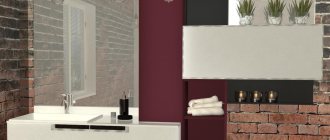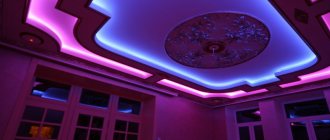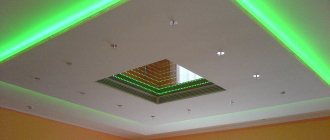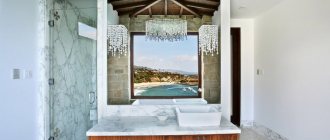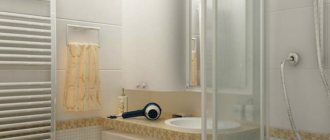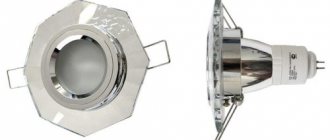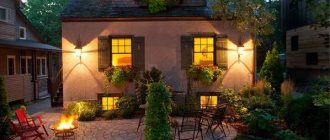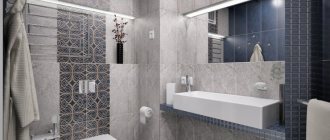Advantages and disadvantages of a luminous ceiling
When starting an apartment renovation, you should not ignore the ceiling. After all, this is a space for your imagination to fly. The ceiling structure can be decorated by installing a lighting system in an original way, thereby transforming the interior of the room as a whole.
Ceiling space lighting covers the following benefits:
- the spotlights used are economical;
- the design solution is diverse;
- no need to pre-treat the surface before installation;
- the installation of lighting devices is allowed on any form;
- creating an optical increase in room space;
- the ability to reconfigure devices, depending on the degree of luminescence;
- suspended ceilings with built-in lamps are used for a long time;
- easy cleaning and comfort.
Ceiling lighting can be very original
. Disadvantages include:
- light sources must be at least 10 cm below the ceiling level, so in an apartment with a small wall height their installation is not recommended;
- ceiling lighting does not change after installation of the ceiling;
- Difficulties may arise when installing lighting fixtures yourself;
- When working, technology should be followed to avoid defects.
It is always better to entrust the installation of lighting fixtures to specialists
Installation option
Chandeliers designed for high ceilings have large dimensions. Therefore, their installation, especially with your own hands, must be done efficiently and taking into account all the design features of the product. Ceiling lamps can be installed in two ways:
- attach directly to the ceiling surface. This is how ceiling models are installed. To fix them, you need to use special fasteners that will firmly hold the chandelier on the ceiling and prevent it from tearing out the fasteners due to its heavy weight. This method of fixation is more common in homes, cafes and restaurants;
Note! For safety reasons, when installing such lamps yourself, preference should be given to lightweight plastic models. The risk of them tearing out their own fastenings will be much less compared to metal products.
Ceiling large chandelier
- installation of the lighting fixture at a certain distance from the ceiling surface (suspended models). Such lamps are most often found in industrial or industrial premises, as well as shopping centers and museums. Hanging models are fastened using stylized chains.
Pendant light for high ceiling
Whatever type of installation and model of lighting fixture is chosen, its installation must be carried out efficiently. In this case, the lamp itself must be firmly attached to the ceiling. Otherwise, there is a high risk of the chandelier falling on people’s heads, as well as damage to the ceilings. Therefore, it is better not to take risks here and trust the professionals.
Types of ceiling lighting
Lighting is not only about creating warmth and comfort in a room, but also a design decision. Ceiling lighting can be done using various types of devices. Before choosing one or another type of lamps, you need to determine which ones are optimal for your ceiling.
Suspension
A suspended ceiling is a structure that is installed at a considerable distance from the concrete base. Therefore, this type of ceiling is suitable only for large rooms with a high ceiling level. However, there are some advantages here. So, in suspended ceilings it is possible to install a variety of lighting fixtures, there is plenty to choose from.
To illuminate a suspended ceiling, it is advisable to use the following lighting fixtures:
- Spotlights;
- LED strips and panels;
- flat chandeliers;
- pendant recessed lights;
- fiber optic light sources.
Designers note that the lighting in a suspended ceiling will be original when using several lamps of different types.
Tensioner
If a large number of different lamps can be used for a suspended ceiling, then with a suspended ceiling things are much more complicated. The fact is that the PVC film, which is stretched under the base, does not have super strength and heat resistance. From this we can conclude that it is simply impossible to hang a heavy chandelier directly on this canvas - the film will immediately tear. Also, you cannot install lamps with conventional incandescent lamps, otherwise there is a risk of melting the section of the film next to the device.
To equip the tension fabric, it is allowed to use such electric lighting devices as:
- LED spotlights (recessed);
- hanging and chandeliers specially designed for this type of ceiling;
- LED strips and fluorescent devices.
Spotlights are most often used in suspended ceilings
Concrete or wood
Lighting a wooden or concrete ceiling can be done using different types of lamps. There are no restrictions here. Such bases provide for installation of devices on a hook, anchor or dowel, which are securely fixed in the ceiling. You can hang even the heaviest chandelier and not worry.
Related article: LED lighting in apartment interiors: pros and cons (types of devices)
The lighting system for a concrete base can be equipped using chandeliers with conventional incandescent light bulbs. Both pendant and ceiling-mounted lamp models are suitable. An LED strip around the perimeter of the ceiling will also look good.
Both chandeliers and built-in devices, such as spotlights, are suitable for wooden bases. However, it is not advisable to use them, since the installation process becomes more complicated.
Glowing stretch ceiling as the main solution
Often, professional designers arrange general lighting in a suspended ceiling. It looks very impressive, it seems as if the ceiling is weightless. With the help of stretch fabric and proper lighting, you can create the effect of a night sky, and if pure white PVC film is used, then there will be a bright glow of the entire ceiling space.
Simple and at the same time unusual
There are some nuances in the suspended ceiling and its lighting:
- Using PVC fabric with 50% transparency, which is practically no different from transparent film.
- To make a luminous ceiling, install an LED strip or spotlights in the space between the concrete base and the tension fabric itself.
- There are several types of tape: it is available in both white and other colors.
The amazing glow of the starry sky right above your head
In the video: LED ceiling lighting.
Types of lamps for ceiling lighting
Modern lighting today is diverse and the consumer market offers a lot of options for lighting devices. These are not only ordinary chandeliers and spotlights, but also lighting made by track systems and flexible designs. When choosing lighting, you should pay attention to the characterizing parameters of the room, for example, the height and area indicators, as well as its purpose.
Chandeliers
The most commonly used type of device for lighting a room is chandeliers. They are divided into:
- Hanging. Direct the light stream straight down. Typically, such a suspension is made on a cord, chain or other material.
- Ceiling. These devices shine upward, evenly distributing the light flux. They come in different shapes (round, square, rectangular), and are attached directly to the ceiling using a strip.
- Classic. The design of these devices is the most common; many lamps are used, and the main structural elements are made of metal, glass, fabric or crystal. Suspended from a hook in the ceiling.
Spotlights
Ceiling lighting includes the use of spotlights. The quantity of this type of lamp is determined by calculation, based on the power indicator of the devices. Spot lighting can act both as primary and additional lighting.
The division of spotlights is made according to:
- installation method - built-in, suspended or overhead;
- type of lamps - halogen, LED, fluorescent, incandescent lamps;
- execution - can be either rotary or non-rotary.
Track systems
These are original lamps mounted on rails - the so-called busbars. The structure can have several locations, depending on the design. Fixing to the ceiling is carried out using special cables and is adjustable to different heights.
It is worth noting that the voltage indicator of light sources can be either 12V or 220V. The latter are characterized by simple installation and safety during operation.
Flexible luminaires
This is another type of lighting that is most often used as additional lighting. Such lamps can be used in any part of the interior; due to their flexibility, they can be installed in ceiling structures of any shape, and are also distinguished by a soft glow.
The glowing effect is created:
- duralight cords;
- LED strips;
- neon tubes.
They are easy to attach to a suspended ceiling and can be used to decorate a plasterboard ceiling. With the right approach, the fixed tape lasts quite a long time and the structure does not require special maintenance. It is still worth making the main lighting, even when using this option of lighting devices.
LED ceiling lighting
Choosing lighting for the ceiling
Lighting based on a semiconductor device - LED - appeared not so long ago, but at the same time it managed to confidently gain leadership among lighting equipment. With the help of LED lighting and backlighting, you can not only create a unique design for any room, but also save money on its subsequent use. Even a beginner can make LED ceiling lighting. The LED, in turn, is a light source that has the following advantages:
- Low power consumption along with good light output;
- Environmentally friendly since it does not contain any dangerous or even harmful gases for humans and the environment;
- The “life” of all lighting and each device in particular does not depend on the number of switches on and off;
- No vibration will affect the life of the LED;
- Low heat generated during operation.
Most often, LED lighting installed on the ceiling is made in a suspended version. So, when installing a suspended ceiling in a room, you need to decide on its type:
- Contour. Diffused light emitted by LEDs located on the shelf, their light directed upward. It forms a continuous light strip;
- Directional lighting. In this case, semiconductor devices are mounted on a slope, and their light flux is directed along the flow. If these are not LED strips, but separate light sources, then the rays diverging to the sides are clearly visible;
- Ceiling spot lighting. LED lights are installed parallel to the floor and shine directly down.
- Starry sky. One of the most difficult types of lighting, since it is necessary to place many separately lit LEDs throughout the ceiling, and an LED strip is no longer enough.
- Shaped lighting. LED lamps are installed in small-sized ceiling lamps.
At the moment, the leaders among LED lighting are strips on which not only the semiconductor devices themselves are located, but also their individual power supply elements. LED ceiling lighting is safer in terms of fire hazard and electric shock, as it operates on low voltage.
How to choose LED strip
To select a suitable LED strip for lighting, you need to understand its types and functional features:
The color of the emitted light flux. The emitted light can be monochromatic or created by a combination of several colors. Special strips equipped with three LEDs of different colors are designed for this purpose. By combining these colors and switching them, you can create unique shades. Brightness adjustment, switching and combination of color shades are performed by electronic controller devices.- Radiation density of one meter of tape for LED backlighting. Each type can contain a certain number of LEDs in one meter of strip. The density of emitters can be 30, 60, 120 pieces per hundred centimeters of length. If a plasterboard niche allows the installation of two strips, then this will only add functionality to the ceiling lighting and give a wide range of different lighting effects, adjustable using a microprocessor controller.
- Power consumption depends on the power of each LED and their number in one meter. That is, it is measured in Watts per meter of length. The total backlight power will be equal to the length of the entire backlight multiplied by the power consumption of one meter of this light-emitting device.
- Supply voltage. For LED strips used in flood lighting, the power supply can be 5, 12 or 24 Volts. Depending on the manufacturer. It is advisable to install the power supply in an accessible place or in a specially made box hidden under a decorative element. The power supply must have a reserve capacity, so it will last longer without emergencies or breakdowns. This type of LED lighting kit most often includes a power source.
LED strips are mounted on a special adhesive tape. Therefore, it is better to install and glue them on plastic than on plasterboard or concrete. Connecting several tapes and bending them must also be done carefully using a reliable connection - through soldering. When installing, be sure to observe the specified polarity, since an LED turned on in the opposite direction may fail.
A suspended ceiling with LED strip lighting looks extremely modern and elegant, and most importantly, practical. Ready-made kits for lighting ceilings of this type can be purchased in specialized stores or online sites, where a large assortment of these products is offered.
Ceiling lighting ideas for different rooms
Today there are many ways to decorate a ceiling using light. When choosing, you should take into account the purpose of the room and what characteristics the lighting fixtures have.
Corridor
A few recommendations for corridor lighting:
- For low ceilings, it is recommended to place lamps with a given direction of light towards the walls and upwards in order to increase the volume of the room.
- If the ceiling level is below average, then the effects of original lighting are achieved using halogen devices.
- To expand the space, lamps should be built in and mounted so that the light falls on the walls.
- If the ceiling level is high, then you can install several hanging lighting fixtures, so the light will fall on the floor.
Related article: Organization of lighting in suspended ceilings: installation and ideas for different rooms | +70 photos
Kitchen
The main or general lighting required for this room is used, additional - local in the form of spotlights, wall sconces. The first type is usually used to illuminate the entire area, and the second in the place of preparation or eating.
Bedroom
Before installing lighting fixtures, you need to make sure where the bed will be located; the routing of the wire depends on this. It is recommended to place the main lighting in the center of the room; you can use a regular chandelier, and hang a night lamp with a halogen lamp on the wall near the bed.
Living room
The main lighting element can be a chandelier located in the center of the room, but it is important to take into account the parameters of the area and the height of the ceiling. If the room is large, then an oversized chandelier will look original. If the living room is small, then the ceiling can be decorated with built-in lamps to visually expand the space.
Bathroom
The ideal solution would be matte or transparent shades. If the ceiling level is very high, then you can hang a chandelier, and if it is low, then it is enough to fix the lamps to the walls. It is worth noting that the selected materials made of colored glass will not be the best option, since the flow of light will be distorted.
Balcony
There is little space in this area, so you can use:
- small table lamp;
- ceiling light source;
- wall placement of sconces.
Usually, for lighting on a balcony or loggia, the choice is made in favor of devices designed for the street.
More about spot lighting
Spot lighting built into a suspended or suspended ceiling has become popular today. The types of lamps used are practical and are used for a long time. Spot light is scattered evenly over the entire area, which ensures normal illumination.
Key Features
Spotlights placed on a suspended or suspended ceiling illuminate a small area. The dispersion angle does not exceed 30. Therefore, these devices should be placed close to each other. The streams of light have the shape of a cone, which means that they must intersect at the same level, located above all objects and furniture.
Advantages and disadvantages
Advantages of spotlights:
- can be used to highlight certain places;
- have low power consumption;
- can be installed anywhere;
- are small in size;
- emit quite bright light;
- Possibility of execution in different colors.
There are also disadvantages:
- design complexity;
- use of additional power supplies;
- should not be used for low ceilings;
- If overheated, defects may remain on the suspended ceiling.
LED lamps versus chandeliers: which is better?
Lamps with a built-in LED module are now very popular.
They have a number of undoubted advantages:
- The device produces light that is evenly distributed over the entire area of the room.
- You can forget about replacing a light bulb for a long time.
- The LED lamp significantly reduces energy consumption.
- Doesn't overheat.
- You can switch light modes (daylight, cold, warm).
- Durability (up to 15 years).
In addition, the lower cost of a good chandelier speaks in favor of LED. However, a chandelier looks much more beautiful and can completely change the visual perception of a room. From a purely practical point of view, in the “confrontation” of LED lamps and chandeliers it is fair to talk about a fighting draw. Both types of ceiling lights have a number of pros and cons. So the purchase of a particular device is usually determined by personal choice, as well as the tasks and design features of the room.
Placement of lamps
Spotlights can be placed in different ways, it all depends on the functionality of the room and the design idea. But most often the following lamp placement options are chosen:
- parallel to each other;
- along the perimeter of the ceiling;
- in the form of an arc;
- circle or square;
- cross;
- in a checkerboard pattern.
How to calculate the number of lamps
To calculate the number of spot lighting devices, it is necessary to measure the ceiling area. So, with a lamp power of 35 W, 1.5 m2 can be illuminated (20 W illuminates 1 m2). With additional lighting, for example, a chandelier, the number of spotlights is reduced.
Illumination standards are presented in Lux per 1m²
It is worth noting that there are types of spotlights equipped with a rotating mechanism or with a lamp inside, this allows you to increase the dispersion angle. Based on this, you can purchase fewer lamps.
On video: how to calculate the number of lamps in a suspended ceiling.
Minimum distance
When choosing spotlights, the following must be considered:
- a distance of at least 20 cm must be maintained from the walls to the lamps;
- between the devices themselves must be left at least 30 cm;
- the distance from the seam of the PVC film should also be more than 20 cm;
- one lamp will illuminate an area of 1.5 m2.
These requirements must be met so that overheating does not occur and, accordingly, the integrity of the material is not compromised (in the case of a stretch ceiling - PVC film).
Article on the topic: Chandeliers in the interior of different styles: help in choosing (+130 photos)
Spot lighting in different rooms
Spot lighting is used in absolutely any room, not only in the living room, bedroom, but also in the hallway, bathroom, toilet and corridor. This is the optimal solution if the apartment area is small. But here it is worth considering that spotlights must be installed in a suspended or suspended ceiling structure, and it is not suitable for every room.
Before installing such lamps, it is necessary to make markings on the film or sheet of plasterboard, taking into account:
- ceiling area;
- purpose of the room;
- general design;
- number of available chandeliers and sconces.
Hallway
The light should be saturated with bright tones, but not to such an extent that the light hurts the eye. The best option is to create diffused light. Spotlights can be arranged in numerous bunches, and a chandelier can be placed in the center.
Kitchen
For any owner, light in the kitchen is a must. It is necessary to maintain the distance between lighting devices, and also calculate their power. When choosing an additional light source, the number of main lamps must be reduced.
Living room
One of the solutions when decorating a living room is the use of combined lighting. Spotlights are evenly located relative to the main light source or along the perimeter; here you need to take into account the possibility of adjusting the power.
Bedroom
To prevent the light from being noticeable, it is recommended to place spotlights on the steps of the ceiling or along its perimeter. It is better to set the number of lamps less than what was calculated. To adjust the lighting, it is recommended to use a dimmer.
Children's
Lighting is created by point light sources above the children’s workplace, for example, where they draw or do other creative work. In addition, using spotlights of different powers and light, you can create an imitation of a fairy tale for children.
Bathroom
To illuminate this room, no more than two spotlights are sufficient, since the area is usually no more than 5 m2. Everything is determined by calculation. Under any circumstances, it is worth considering that the sealed design of lighting devices is important and the ideal solution would be to use halogen lamps.
Options for suspended ceilings
This type of ceiling is equipped with several types of lamps. The only distinguishing feature is the depth of installation of live parts. The use of mortise lighting devices is most important, and a ring is attached around the lamps to prevent the film from tearing.
Above ceiling level
Lighting fixtures installed above the ceiling create the effect of glowing from within. It looks great, but it has a number of disadvantages:
- the area is not fully illuminated;
- the lamps may become very hot;
- the need to use LED lamps.
At ceiling level
Recessed spotlights are installed directly into the ceiling structure itself. The lighting of the space is carried out depending on the idea. But the light dispersion coefficient is quite high. Lamps with a power exceeding 35 W cannot be installed, and a transformer must be installed.
Below level and overhead
The main distinguishing characteristics of such lighting are a large percentage of light dispersion. This category includes spotlights that are also built into a suspended or suspended structure, but the lighting element extends beyond the ceiling. They may have glass shades and hanging decorative elements.
For the installation of surface-mounted lamps, a special base is used, which allows the use of lamps of different power ratings.
Other options
Using fiber optic spotlights, you can create an imitation of the starry sky. Two-level stretch ceilings with additional lighting are quite original in their solution. It is worth considering that when choosing minion type lamps, one element is installed per 2 m2.
Neon ceiling lighting
Facade LED lamps - an element of building lighting
To create this type of illumination, classic glass or plastic tubes are used, on the walls of which a phosphor is applied. It is this that allows the device to emit light radiation. Electrodes are installed at the ends of the lamp tube to supply power voltage, and an inert gas, neon, is filled inside the tubes. In order for the device to emit light, a voltage converter is needed from the usual 220 Volts to a special high voltage for the ionization of neon. Moreover, the color emitted by this device depends on the composition of the phosphor. A distinctive feature of this lamp is the absence of an incandescent filament, so their operating life is 10-15 years. Most often, the length of such tubes is 1.5 m and the diameter is from 8 to 15 mm. Multi-level ceilings with neon lighting create a unique soft shade.
Unusual ideas for placing lamps
To create a new lighting project, you can be guided by creative ideas:
- arrange spotlights in a snake pattern;
- place one type of lamps in the corners, and mount another in the center;
- choose different colors and arrange them symmetrically;
- arrange spotlights in a semicircle relative to the walls.
You can draw any drawings, take photos and implement ideas, the main thing is to take into account the installation rules.
DIY stretch ceiling lighting (2 videos)
Various ideas (80 photos)
The living room creates an atmosphere of comfort
Since this is your central room at home, it’s worth making it beautiful and unique, let’s focus on LED ceiling lighting. Safety is also important, so we place the chandelier high enough; the minimum distance from the surface of the tables cannot be less than one and a half meters. You can always supplement the lighting of a stretch ceiling with small spotlights. Let these be beautiful decorative sconces and floor lamps; directional light lamps from the corners will also come in handy. And that is not all! If there are sculptures and paintings hung in the living room, you need to take care of local lighting of works of art. This is the only way you can turn even a very large, uncomfortable room into an apartment for relaxation and comfort. The height of the room will also play a role here - large chandeliers in such rooms look rich and bright.
